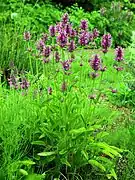Betonica officinalis
Betonica officinalis (syn. Stachys officinalis), commonly known as common hedgenettle,[2] betony,[3] purple betony, wood betony, bishopwort, or bishop's wort, is a species of flowering plant in the mint family Lamiaceae, native to Europe, western Asia, and northern Africa.[1]
| Betonica officinalis | |
|---|---|
.jpg.webp) | |
| Scientific classification | |
| Kingdom: | Plantae |
| Clade: | Tracheophytes |
| Clade: | Angiosperms |
| Clade: | Eudicots |
| Clade: | Asterids |
| Order: | Lamiales |
| Family: | Lamiaceae |
| Genus: | Betonica |
| Species: | B. officinalis |
| Binomial name | |
| Betonica officinalis | |
| Synonyms[1] | |
| |
Pliny (25, 8, 46, § 84) calls the plant both betonica and vettonica, claiming that the Vettones used it as a herbal medicine. It is commonly known as Stachys officinalis, the word stachys coming from the Greek, meaning "an ear of grain," and refers to the fact that the inflorescence is often a spike.
The Latin specific epithet officinalis refers to plants which had a culinary or medicinal use.[4]
Description
Betonica officinalis is a rhizotomous,[5] patch-forming, grassland herbaceous perennial growing to 30–60 cm (12–24 in) tall. Its leaves are stalked on upright stems, narrowly oval, with a heart-shaped base, with a somewhat wrinkled texture and toothed margins. The calyx is 5–7 mm long, with 5 teeth, edged with bristles. The corolla 1–1.5 cm long. Its upper lip flat, almost straight when seen from the side. The anthers stick straight out. It flowers in mid summer from July to September, and is found in dry grassland, meadows and open woods in most of Europe, western Asia and North Africa. In the British Isles it is common in England and Wales, but rare in Ireland and northern Scotland.
The aerial parts contain phenylethanoid glycosides, (betonyosides A-F) and acetoside, acetoside isomer, campneosides II, forsythoside B and leucosceptoside B.[6] The roots contain diterpene glycosides, betonicosides A-D and the diterpene, betonicolide.[7]
.jpg.webp) In flower
In flower Basal leaf
Basal leaf Stem leaves
Stem leaves In cultivation
In cultivation Leaf adaxial side.
Leaf adaxial side. Leaf abaxial side.
Leaf abaxial side.
Culture

Folklore
The first reference to betony occurs in a work by the Roman physician Antonius Musa, who claimed it as being effective against sorcery. It was planted in churchyards to prevent activity by ghosts.
The Anglo Saxon Herbal recommends its use to prevent "frightful nocturnal goblins and terrible sights and dreams". A Welsh charm prescribes: to prevent dreaming, take the leaves of betony, and hang about your neck, or else drink the juice on going to bed.[8]
Proverbs and sayings
An Italian proverb advises that you should "Sell your coat and buy betony", whereas a Spanish compliment states, "He has as many virtues as betony".
Herbal use
The plant was commonly grown in physic gardens of apothecaries and monasteries for medicinal purposes, hence the specific epithet officinalis which indicates use for medicinal or culinary purposes.[4]
Betony was an ingredient of "pistoja powder," an old remedy for arthritis and gout.[9] It was also claimed to be effective against snake and dog bites, and was believed to be a cure for drunkenness. Richard E. Banks stated that you should "Eat betony or the powder thereof and you cannot be drunken that day."
John Gerard (1597) said that "It maketh a man to pisse well" While Nicholas Culpeper stated that, "...it preserves the liver and bodies of men from the danger of epidemical diseases, and from witchcraft also" and "...this is a precious herb, well worth keeping in your house". He also states that betony is astrologically ruled by Jupiter and Aries.
Betony has also been used in traditional Austrian medicine internally as tea, or externally as compresses or baths for treatment of disorders of the respiratory tract, gastrointestinal tract, nervous system, skin and gynecological problems.
Modern herbalists prescribe betony to treat anxiety, gallstones, heartburn, high blood pressure, migraine and neuralgia, and to prevent sweating. It can also be used as an ointment for cuts and sores.
References
- "Betonica officinalis L." Plants of the World Online. Royal Botanical Gardens Kew. Retrieved 31 March 2021.
- USDA, NRCS (n.d.). "Stachys officinalis". The PLANTS Database (plants.usda.gov). Greensboro, North Carolina: National Plant Data Team. Retrieved 30 November 2015.
- David Chapman (2008). Exploring the Cornish Coast. Penzance: Alison Hodge. p. 113. ISBN 9780906720561.
- Harrison, Lorraine (2012). RHS Latin for Gardeners. United Kingdom: Mitchell Beazley. ISBN 978-1845337315.
- "Ecological Flora of Briain & Ireland". Retrieved 19 September 2021.
- Miyase T., Yamamoto R., Ueno A.,"Phenylethanoid glycosides from Stachys officinalis" Phytochemistry 1996 43:2 (475–479)
- Miyase T., Yamamoto R., Ueno A. ,"Betonicosides A-D and betonicolide, diterpenoids from the roots of Stachys officinalis" Chemical and Pharmaceutical Bulletin 1996 44:8 (1610–1613)
- Bonser Wilfrid, "Magical Practices against Elves" Folklore, Vol. 37, No. 4 (Dec. 31, 1926), pp. 350-363
- Literary Notes, The British Medical Journal Vol. 2, No. 2504 (Dec. 26, 1908), p. 1876